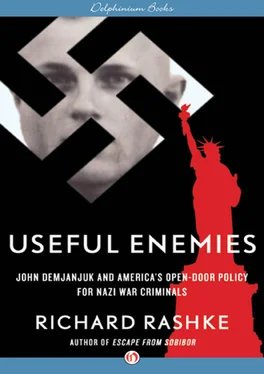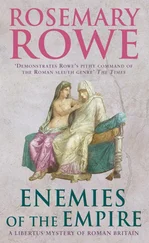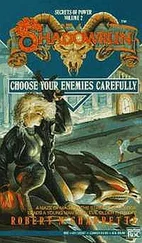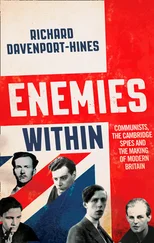Pritchard testified that both Altman and Smith used photo comparison techniques that were untested and not accepted in the scientific community. Echoing the conclusion of Iscan, Pritchard explained that the images they created were so suggestive to the human eye as to be little more than optical illusions. And conclusions based on optical illusions were themselves illusions.
Pritchard concentrated on Altman. She studied photos of Altman’s cut-and-match display provided by Gill and testified that Altman had altered the photographs when he cut and sized them for the comparison. His matches were fake. In effect, Pritchard was calling Altman a forensic fraud. A snake-oil salesman.
To prove her point, Pritchard randomly selected photos of twelve male models from magazines. Then she cut each picture in half and reassembled them, randomly placing half of one model’s picture next to half of another model, just like Altman had done with his Trawniki card photo and his proven photos of John Demjanjuk. Ten out of twelve of Pritchard’s randomly selected and matched photo halves appeared to be just as correlated as Altman’s Demjanjuk photo halves. The pieces reasonably matched.
Pritchard smiled at the court as if she had just scored a first-round knockout. The bench did not smile back. It was not impressed with her theories or her unscientific demonstration. If Shaked had been rough on Edna Robertson, he showed no mercy with Anita Pritchard, who had just called one of his expert witnesses a fraud. Shaked’s plan was not to humiliate her on the stand as he had Edna Robertson, but to completely break her.
Shaked began the destruction of Anita Pritchard by challenging her credentials as an expert witness. Was she an anthropologist?
No.
Was she an anthromorphologist?
No.
Was she a morphologist?
No.
Did she have any specialized knowledge of morphology of the face?
No.
Had she published any articles in professional journals dealing with the psychology of visual perception, her specialty?
No.
Did she read—or even know—the professional journals relevant to her field?
Only a few.
How much did she know about neurology?
A little.
Physiology?
A little.
Optics of the eye?
A little.
“Since you don’t know these disciplines, how can you talk about visual perception?” Shaked demanded. He moved on to her in-court, photo-halves demonstration.
Was her sliced-photo demonstration based on scientific criteria?
No.
She said she randomly selected the photos used in the demonstration. Did she even know the rules for random selection?
No.
Did she analyze Altman’s work from his original display or from photos of his display?
Photos.
From photos? How can you call yourself an expert?
Shaked wasn’t finished with Pritchard just yet. He got her to admit that the only book she had authored was self-published; that Columbia Pacific University was not an accredited school; that her master’s in psychology from the University of Oklahoma was granted by the department of human relations, not the department of psychology; and that most of her education in graphology was through correspondence courses.
“You’re creating an illusion that you’re an expert,” Shaked hammered. “Maybe you should take back what you told the court earlier…. Tell the court you’re not an expert.”
In the end, Pritchard, who had finally reviewed Altman’s original photos and montages between court sessions, recanted her earlier testimony. “My entire qualified opinion must be removed from my testimony…. There were no alterations in the Altman composites. If offense was taken, I apologize.”
As Pritchard left the stand, Shaked offered his hand as if to say, “I’m sorry. I was just doing my job.”
The defense of John Demjanjuk had just turned from disaster to catastrophe.
Pritchard locked herself in her hotel room that evening. When she didn’t appear for dinner, Sheftel thought he better check to see if she was okay. He called her room. She didn’t pick up. He knocked on the door and called her name. She didn’t answer.
Sheftel found the hotel manager and told him that something was wrong with his guest, Ms. Anita Pritchard. She didn’t answer the phone or the door. Sheftel and the manager rushed to her room and unlocked the door with a master key. They found Pritchard in her pajamas spread-eagled on the bed and unconscious. She had swallowed a bottle of pills.
Sheftel rushed Pritchard to the emergency room, where a doctor pumped her stomach. When she became aware that she had failed to kill herself, she ripped out the intravenous tubes. Nurses reattached them and watched over her. Pritchard returned to Houston a few days later.
At this critical point in the trial, the defense was frustrated, humiliated, and desperate. Shaked had crushed Edna Robertson. He had turned William Flynn into a prosecution witness. He had dismissed Yasser Iscan as irrelevant. And he had completely destroyed Anita Pritchard.
If that wasn’t enough grief for the embattled defense, time was fast running out. It needed a big gun, an expert among experts, a forensic scientist with impeccable credentials. Sheftel asked Ed Nishnic to find such a person and fast. He would be the defense’s last hope. The redeemer.
Nishnic found Julius Grant.
• • •
Eighty-six-year-old Julius Grant was a British chemist with a doctorate in toxic metals from the University of London; an internationally recognized expert in handwriting, paper, and ink analysis; and a highly sought-after freelance expert on dating documents and paintings. He had more experience as a historic document examiner than all the prosecution experts combined, and he had served as an expert witness in more than seventy countries around the world, a record no expert witness before him could even come close to matching.
It was Julius Grant who had conclusively proven for the London Sunday Times that the Hitler Diaries were fake. He reached his unqualified and undisputed conclusion in just five hours by chemically determining that the ink used in making the diaries was recent ink, not ink from the 1940s. Grant had also proven that the “Mussolini Diaries” were forgeries and that the mummy of Egyptian pharaoh King Tutankhamen, discovered in 1922, was authentic.
Grant’s task as a defense witness was huge—prove that all five prosecution expert witnesses—Bezaleli, Epstein, Altman, Robertson, and Smith—were wrong in one way or another, by showing that at least one important element on the Trawniki card had been forged. As Grant took the stand, his boney hands and slight frame belied his physical strength and inner resolve. But he quickly showed the court just how tough he was when he declined the chair Judge Levin offered him and remained standing for the entire three days of his testimony, which was articulate, reasoned, precise, clear, and cautiously wise.
Grant made it clear to the court that he based his analysis of the Trawniki card signatures on two graphology principles. First: “Handwriting comparison is not an exact science…. You cannot identify a person with certainty from handwriting…. There are times when the forger is more clever than the handwriting expert, as in the Hitler Diaries. ”
Second: “When a person signs his name—whether he does it once, twice, or a thousand times—he never does it twice exactly the same.”
With those two conditions in mind, Grant analyzed the original Trawniki card, the original and proven signatures of Karl Streibel, photos of—but not the original proven signatures of—Ernst Teufel, the card paper and ink, the questioned Demjanjuk photo, the perforations on the card, and the ink in the perforation holes.
Читать дальше












